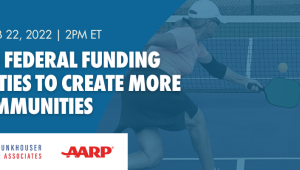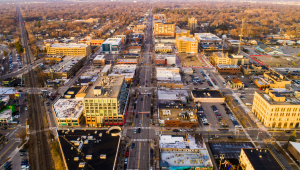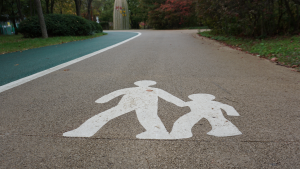
Livable Communities
Explore how to make communities livable places for people of all ages.About ELGL & AARP's Livable Communities
ELGL is excited to partner with ArtPlace America and CivicArts to write, explore, share, and learn about creative placemaking and how we use arts and culture to shape our communities! We know that when all local government departments - from public works, to libraries, to budget offices (and everything in between) - use creative approaches, the result is stronger, more inclusive communities.
We’re kicking off this partnership with a robust blogging, podcasting, and webinar series to engage the local government community with stories and examples about how communities use arts and culture in all aspects of local service.
If you would like to share your community's creative placemaking story with the ELGL community, reach out to ELGL Digital Coordinator, Allie.
About Our Partners
Approximately 45 million Americans are age 65 or older. By 2030, that number will reach 73 million Americans. At that point, fully one in five Americans will be older than 65. By 2034, the United States will — for the first time ever — be a country comprised of more older adults than of children. AARP Livable Communities supports the efforts of neighborhoods, towns, cities and rural areas to be great places for people of all ages. AARP believes that communities should provide safe, walkable streets; age-friendly housing and transportation options; access to needed services; and opportunities for residents of all ages to participate in community life.
Contact Us: Livable@AARP.org | Twitter: @AARPLivable | Facebook: @AARPLivableCommunities
Free, Weekly Newsletter: AARP.org/LivableSubscribe

Livable Community Resources
Conceiving Arts-Based Opportunities (BELOW ARE SAMPLES OF HOW THIS SECTION CAN LOOK)
Understanding Creative Placemaking
Ann Markusen and Anne Gadwa, National Endowment for the Arts
This 2010 white paper commissioned by the National Endowment for the Arts is an important early resource and codified the term creative placemaking. The report outlines the ways that leaders and participants from different sectors can use place-based art to pursue a variety of positive outcomes, including streetscape improvements, economic activity, and public safety. An early understanding of creative placemaking coalesced in this report, and the field still builds on it and reckons with it.
How to Do Creative Placemaking: An Action-Oriented Guide to Arts in Community Development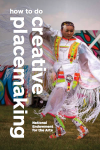
National Endowment for the Arts
This guide provides practical strategies, precedent, and best practices for municipal and community leaders to use creative placemaking for equitable social and economic development, celebrating community identity, governance, and physical design.
Creative Placemaking: Knowledgebase Collection
American Planning Association
This Knowledge Center portal from the American Planning Association allows you to search for resources that provide background and policy guidance on creative placemaking. You can also filter search results by various graphic and demographic characteristics.
Exploring Our Town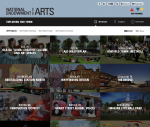
National Endowment for the Arts
Creative placemaking projects strategically link communities and local governments with artists, designers, and arts organizations to improve quality of life, create a sense of place, and revitalize local economies. This online resource of over seventy case studies gives examples from across the nation on how different communities are harnessing the capacity of arts and culture based strategies.
Creative Placemaking Toolkit for Counties
National Association of Counties
As public funding becomes increasingly strained, counties must search for and employ new strategies to improve their communities and local economies. NACo, in partnership with Americans for the Arts launched the Creative Counties Placemaking Initiative to support counties as they work to identify and strengthen ways to integrate arts into solutions to local challenges.
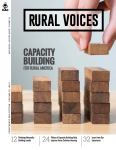 Rural Placemaking: Making the Most of Creativity in Your Community
Rural Placemaking: Making the Most of Creativity in Your Community
Housing Assistance Council
The publication Rural Voices examines creative placemaking as it is practiced in rural communities. Though the term “creative placemaking” is only about a decade old, these articles recognize that rural community organizations have long taken on community-building endeavors that have included the arts.
Native American Creative Placemaking
Housing Assistance Council
The report examines a handful of established Native American creative placemaking efforts while offering a first of its kind interactive map of Native American creative placemaking projects.
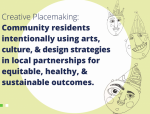 The Creative Placemaking Values Guide
The Creative Placemaking Values Guide
A discussion guide designed for creative placemaking initiative partners to surface and develop agreement on a shared understanding of the underlying values in their work.
 The Municipal Artist Partnership Guide
The Municipal Artist Partnership Guide
Created by A Blade of Grass & Animating Democracy
The rich resource provides nuts and bolts advice, project examples, and templates for all kinds of partnerships between artists and local government entities.
Understanding Community Development in a New Way
Cultivating Creativity: Exploring Arts & Culture in Community Food Systems Transformation
Arts & Food Systems
“Cultivating Creativity” examines the potential for the arts to contribute to food systems and agriculture activity and change. The report finds that art can be used in food systems interventions to honor identity and heritage, address and heal community conflict, transform community spaces, drive equitable food development, preserve and reclaim food and farming traditions, and help facilitate community-led processes.
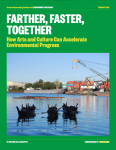 Farther, Faster, Together: How Arts and Culture Can Accelerate Environmental Progress
Farther, Faster, Together: How Arts and Culture Can Accelerate Environmental Progress
Arts & the Environment
This report explores the potential for arts and cultural activity to contribute to community sustainability and resilience, in climate adaptability, energy, water, land, waste, and toxic pollution. The report finds that arts-based activities can help spark public demand by making environmental issues feel personal and real, build community capacity and agency, connected large-scale, abstract issues to personal experience, enrich and activate the built environment, and nurture sustainable economies.
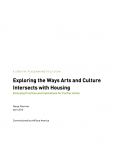 Exploring the Ways Arts and Culture Intersects with Housing: Emerging Practice and Implications for Further Action
Exploring the Ways Arts and Culture Intersects with Housing: Emerging Practice and Implications for Further Action
Arts & Housing
This case study explores how creative placemaking activity contributes to the housing sector of community development. The report finds that arts activity can help articulate invisible housing challenges, nourish those who have experienced housing-related trauma, contribute to organizing housing campaigns, create bridges between residents, stabilize vulnerable communities, and generate economic development opportunities.
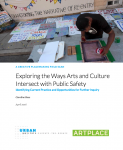 Exploring the Ways Arts and Culture Intersect with Public Safety: Identifying Current Practice and Opportunities for Further Inquiry
Exploring the Ways Arts and Culture Intersect with Public Safety: Identifying Current Practice and Opportunities for Further Inquiry
Arts & Public Safety
This scan considers the positive impact of place-based creative activity on public safety. They find that arts-based projects can enhance public safety efforts by promoting empathy and understanding, influencing law and policy, providing career opportunities, supporting community well-being, and contributing to quality of life.
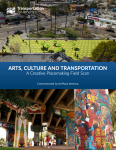 Arts, Culture and Transportation: A Creative Placemaking Field Scan
Arts, Culture and Transportation: A Creative Placemaking Field Scan
Arts & Transportation
This report identifies seven ways that creative placemaking contributes to equitable transportation development: generating creative solutions for entrenched transportation problems, making streets safer for all users, organizing transportation advocates, engaging multiple stakeholders for an inclusive process, fostering local ownership, alleviating the disruptive effects of construction, and healing wounds and divisions.
Grounding Efforts in Equity & Inclusion
 Placemaking and the Politics of Belonging and Dis-belonging
Placemaking and the Politics of Belonging and Dis-belonging
Roberto Bedoya, 2013
Roberto Bedoya impacted the direction of the field with this article, which is critical of what he sees as creative placemaking’s emphasis on neighborhood revitalization and economic development. He points out that without honoring equity, race, and justice at the center of creative placemaking, arts-based practice can easily be misapplied to reinforce existing barriers to opportunity and sense of belonging for marginalized people. He advocates for using creative placemaking to foster belonging and to achieve “strength and prosperity through equity and civility.”
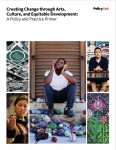 Building A Cultural Equity Plan
Building A Cultural Equity Plan
PolicyLink
This tool demonstrates the equity components that can be applied to the development of a Cultural Equity Plan. Cultural equity explicitly values the unique and collective cultures of diverse communities and supports their existence in physical spaces, in public policies and investment, and in expression in civic and spiritual life.
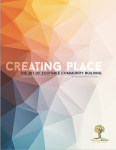 Creating Place: The Art of Equitable Community Building
Creating Place: The Art of Equitable Community Building
AlternateROOTS
Creating Place is a multimedia collection of explorations, reflections, challenges, and offerings to the national dialogue around creative placemaking

